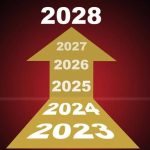At the Children’s National Hospital Grand Rounds in Washington, D.C., I had the opportunity to deliver the Annual Holbrook Lecture. There, I embarked on a journey through time, tracing the evolution of knowledge dissemination through to the transformative power of generative AI and its potential application to American medicine.
A brief history of knowledge diffusion
The Gutenberg Revolution: I began by reflecting on the monumental shift in knowledge brought about by Johannes Gutenberg’s invention of the printing press in the 15th century. This innovation democratized knowledge, making books accessible to many rather than a luxury for the elite. The rapid diffusion of knowledge laid the foundation for modern education systems and public libraries.
The Dawn of the Internet: Fast forward to the mid-20th century, the Cold War era. The need for secure communication between military leaders in the U.S. led to the creation of a distributed network of communication cables, the precursor to the modern-day internet. This innovation further democratized access to knowledge, placing it right at fingertips of the majority of Americans.
The Mobile Revolution: As we entered the 21st century, visionaries like Steve Jobs saw the potential of mobile communication as more than just portable telephones. The integration of cameras, music players, and internet connectivity transformed these devices into powerful tools, making global knowledge accessible from our pockets.
The rise of generative AI
These advancements in knowledge availability were undoubtedly transformative. However, the emergence of generative AI, particularly ChatGPT, promises to be even more revolutionary. This technology is not just about providing information but offering expertise. The rapid evolution of ChatGPT suggests that in just five years, it could be 30 times more potent than it is today.
Generative AI empowers individuals in unprecedented ways. It allows those without a background in poetry to craft verses, non-musicians to compose songs, and budding artists to paint with the finesse of masters. In the realm of healthcare, it bridges the knowledge gap between medical professionals and patients, fostering a collaborative approach to health and wellness.
The three eras of AI
What people refer to as AI varies tremendously by its underlying design. Rule-based AI, for example, was the earliest form of AI. It relied on heuristics derived from human experts. It was fast and powerful but limited by the knowledge of its creators. Next came narrow AI. This form of AI uses vast datasets for comparison to create its own rules and became superior to humans in terms of analyzing mammograms or defeating grandmaster chess players. Narrow AI excels in specific tasks but lacks broad applicability. Most recently, there’s generative AI. ChatGPT is the current frontier, a pre-trained AI that relies on vast amounts of data. This large language model understands relationships between different data points and generates new content to questions on nearly every subject, based on the parameters and patterns it has learned.
Applications and challenges
Speaking to an audience of attending physicians, residents in training and healthcare administrators, I delved into five critical applications of AI in medical care and how generative AI will allow clinicians to provide superior quality with improved safety in more affordable ways:
- Helping doctors and patient to better manage chronic diseases
- Reducing the 400,000 annual misdiagnoses
- Enhancing patient safety and preventing the 200,000 deaths due to medical errors
- Lowering overall healthcare costs
- Addressing physician burnout
However, with these opportunities come challenges, including outdated data, concerns about privacy and security, potential biases, and the risk of over-reliance on technology.
The future
The future of healthcare is poised at the intersection of technology and human expertise. In the conclusion to my lecture, I went back to the question posed in the title of my talk: Is ChatGPT the clinician’s friend or foe?
For those individuals who believe the American healthcare system is as good as it gets and want to maintain the status quo, ChatGPT will be a massive foe. But for those who want to transform American medicine—who believe that every American deserves excellent care regardless of socioeconomic status or race or where they live—this will be a powerful tool and friend. Led by clinicians, it will allow us to make American healthcare the best in the world once again.
The choice is ours to make.
Thank you to all who attended, and to the event organizers. Special thanks to David Wessel, M.D., the executive vice president, chief medical officer and physician-in-chief at Children’s National Hospital, as well as Ifeyinwa Egwuatu, program coordinator in the Office of the CMO.
I encourage all healthcare providers to explore the power of ChatGPT and other generative AI tools. Imagine what will be possible when the application is 30 times more potent in the next five years (or sooner). I encourage all who attended to let me know about their experience and the opportunities they identify to improve clinical outcomes and make medicine better for both the recipients of medical care and the providers.
* * *
Dr. Robert Pearl is the former CEO of The Permanente Medical Group, the nation’s largest physician group. He’s a Forbes contributor, bestselling author, Stanford University professor, and host of two healthcare podcasts. Pearl’s newest book, “Uncaring: How the Culture of Medicine Kills Doctors & Patients,” is available now. All profits from the book go to Doctors Without Borders.






